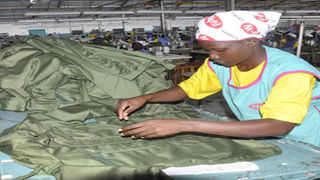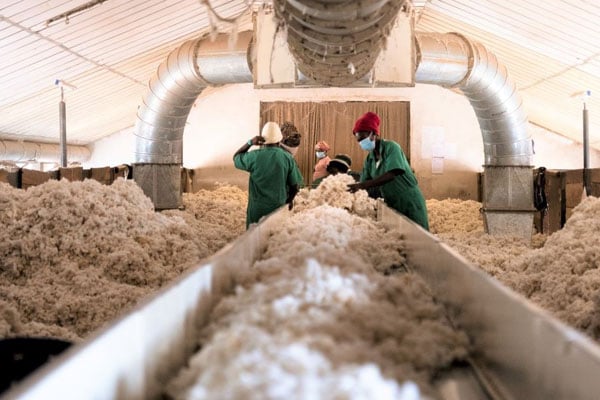
A woman makes clothes in a factory. Cotton is the main source of income for some 250,000 households, who cultivate cotton under rain-fed conditions and with minimal use of inputs such as fertilisers and chemicals. PHOTO/FILE
|Prosper
Prime
The rise, fall of Uganda’s cotton industry
What you need to know:
Over 90 per cent of Uganda’s lint is exported at a miserable price of less than $1 (Shs3,757) per Kilogramme, and is entirely dependent on the increasingly fluctuating international commodity prices.
The cotton sector is in decline, Prosper Magazine can reveal.
The cash crop ranked by Cotton Development Organisation (CDO) as the third leading export commodity after coffee and tea is still largely exported in unprocessed form.
This is further complicated by the low spinning and weaving capacity, high cost of finance, exorbitant infrastructure costs, and weak linkages along the value chain.
Despite most parts of the country having potential to produce cotton, Prosper Magazine has also established that competition from other crops, price volatility and heavy reliance on counterfeit and second hand articles/garments have all dealt a blow to the growth of the sector value chain.
Effect of this is conspicuously evident in the fledgling if not stagnating textile industry. This can also be seen in the current under performance of the cotton by-product value chain.
According to CDO, cotton is the main source of income for some 250,000 households, who cultivate cotton under rain-fed conditions and with minimal use of inputs such as fertilisers and chemicals.

Mr Tom Kibirige, a tailor, makes clothes in Kiyembe, Nakasero. Uganda’s textile manufacturing infrastructure is under developed. PHOTOs/ MICHAEL KAKUMIRIZI
Even with the great market potential, opportunity to practise commercial farming and the fact that the country’s organic cotton can be marketed as niche brand, the value chain, remains unresponsive and in position of decline.
In his assessment, the Economic Policy Research Centre (EPRC) researcher, Dr Paul Corti Lakuma, partly attributes the collapse of the cotton sector to efficiency gains in the textile sector and emergence of synthetics and fabric blending technology.
The EPRC Research Fellow further argues that the ban on second hand clothing is not a solution to the problems facing the sector “as there is still competition to be dealt with from the efficient Asian textile industry.”
As for the national chairman, Uganda Tailors Association, Mr Philip Ssekimpi, the decline is visible in their daily operations.
He said: “We don’t have enough quality locally sourced fabric to work with. This means we cannot churn out quality products from poorly produced raw material, explaining why appetite for foreign made clothes or the mivumba are so high.”
He continued: “Given the monopoly in the industry, the cost of fabric is exorbitant for majority of the population to afford. This has been worsened by lack of capacity and proper data to use to cluster the textile industry players.”
Historical facts
Historically, Uganda is known as a cotton producing country that once recorded an annual production of 254,000 bales, and with the potential of producing 1,000,000 bales at full employment level.
However, over 90 per cent of the lint produced in Uganda is exported at a miserable price of less than $1 per Kilogramme, and is entirely dependent on the increasingly fluctuating international commodity prices, according to data from the Trade Ministry.
This, according to a sector report, resulted into loss of value to Uganda since conversion of such lint translates into 8-10 fold growth in value when conventional cotton is processed fully into garments.
The persistence of the above situation limits the tax-base, exports, purchasing power, employment creation, and inhibits economic transformation which, in part, explains the deteriorating terms of trade for Uganda with all major trading partners. Partly, it is for this reason that the National Textile Policy, had to be formulated to facilitate the sub-sector’s growth.
Talking statistics
According to Textile Infomedia, a global textile industry listing from various regions and countries, Uganda Textile and Apparel Sector Exports contribution amounts to $66.61 million while textile and clothing sector Import Contribution stands at $268.81 Million. The disparity in imports and exports is staggering for a country whose cotton could be exported as niche product.
Top export destinations for Uganda are Singapore and the neighbouring Democratic Republic of Congo all with $14 million each in export. Then followed by Kenya ($ 5.76 million), Portugal ($ 5.37 million), and finally South Sudan ($ 3.28 million).

A woman displays a T-shirt made at a factory in Kampala. PHOTO/FILE
And Uganda’s top textile and garment imports are from China and worth $135.92 million with import share of 50.5per cent. Then India at $ 23.3 million with Import share 8.6 per cent, United Arab Emirates at around $ 20.6million with Import Share 7.6 per cent, then Kenya with $ 10.6 Million and Import share of 3.9 per cent and then Pakistan at $10.1 million with Import Share of 3.7 per cent.
Other than the defunct Rayon Textiles in Kawempe and the Uganda Garment Industries Limited (UGIL) all other whose number are on the fingertips are located up-country, near sources of either raw materials or energy. Some of them include: Nyanza Textile Industries Limited (NYTIL) in Jinja, Mulco Textiles in Jinja, African Textile Mills (ATM) in Mbale and Lira Spinning Mill in Lira.
At its peak in 1972/3, the textile industry consumed approximately 400,000 bales of cotton, according to the Trade Ministry report. It further discloses that due to market distortions, the current consumption of cotton lint is about 15,000 bales per annum against the highest annual production of 250,000 bales per annum in the last five years.
Players and participants
According CDO information, in 2020, the amount of cotton lint exported worldwide was estimated at 9.4m tonnes, picking up by 5 per cent compared with the previous year’s figure. In value terms, supplies contracted to $14.6 billion.
The CDO websites further shows that U.S (3.8M tonnes) represented the major exporter of cotton lint, mixing up 41 per cent of total exports with Brazil (2.1M tonnes) holding the second position in the ranking, followed by India (960K tonnes). US, Brazil and India collectively held slightly over 33 per cent share of total supplies.
Then Greece (289K tonnes), Benin (280K tonnes), Nigeria (212K tonnes), Australia (170K tonnes) and Burkina Faso (167K tonnes) fill the blanks left by the leading producers.
In 2020, the most notable rate of growth in terms of shipments among the key exporting countries was attained by India (55.9% per year), while exports for the other global leaders experienced more modest paces of growth.
In value terms, the U.S. ($6B), Brazil ($3.2B) and India ($1.4B) appeared to be the countries with the highest levels of exports in 2020, with a combined 73 per cent share of global supplies.
Uganda’s contribution in the grand scheme of things has been described by sector analysts as “negligible.”
By-products woes
The United Nations Conference on Trade and Development (UNCTAD) and its regional partners, the United Nations Economic Commission for Africa (UNECA) and the Common-Products in Eastern and Southern Africa examined the country’s cotton value chain and found numerous challenges.
Lack of spare parts in the local market; load shedding and erratic power supply; old equipment; an absence of technologies to exploit some by-products like cotton stalks; and an unfavourable business environment are all part of the reasons crippling the sector value chain development.
For example, in milling and oil extraction, cottonseed oil is favoured by bakeries, but it faces numerous impediments like: limited supply of raw material; lack of capital; poor technology and limited technical capacity to purify cottonseed oil; high operating costs and competition from other edible oils like palm oil.
After an extensive consultative process covering government ministries, agencies, academia and the private sector, there is need to revive the cotton and textile sector, resulting in the National Textile Policy and strategy document currently gathering dust in government ministries, departments and agencies.
State of affairs
The government has identified the cotton-textile sub sector as a priority with the view to increase value addition on locally available cotton raw materials and export of manufactured goods to improve the balance of payments position that has over the years deteriorated owing to the predominance of raw material exports.
It is no secret that the country’s current textile manufacturing infrastructure is underdeveloped and falls short of meeting industry expectations. Even in this state of affairs, it estimated that up to 50,000 jobs can be created from the industry in the short term once it is revived.
The sector blueprint also estimates that the textile industry can generate $650 million in exports if the sub sector gets it house in order. Even with the under-performance, the sub sector employs at least 2.5 million Ugandans, mostly women and youth, across the value chain with the potential to more than double the number at full employment level.
Key areas inhibiting the optimal performance of the textile sub sector, according to the sub-sector policy put together by the Ministry of Trade include: unfair trading practices and absence of level playing field due to market distortions arising from export incentives especially in Asia, high cost of doing business resulting from high cost of finance, low industrial productivity and weak domestic trade policies that encourage imports at the expense of local sourcing.
Special attention in the policy currently gathering dust in government offices, has been given to retention and attraction of new investment into the sub sector, developing human resources to address shortage of trained personnel in clothing and textile technology, resolving present market distortions that result into unfair competition between locally made textiles and imports and supporting local textile sourcing by the public sector.





